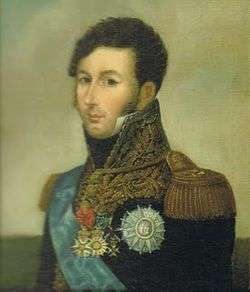Jean-Toussaint Arrighi de Casanova
| Jean-Toussaint Arrighi de Casanova | |
|---|---|
|
General Arrighi de Casanova | |
| Born |
8 March 1778 Corte, France |
| Died |
22 March 1853 (aged 75) Paris, France |
| Allegiance |
|
| Years of service | 1796-1814 |
| Rank | General of Division |
| Commands held | Cavalry, Infantry |
| Battles/wars | |
| Awards | Duc de Padoue |
| Relations | Cousin (in law) of Napoleon Bonaparte |
| Other work | Deputy, Senator, Governor of the Invalides |
Jean-Toussaint Arrighi de Casanova (born 8 March 1778 in Corte; died 22 March 1853 in Paris), duc de Padova, was a French diplomat and soldier of the French Revolutionary and Napoleonic Wars. In the late 1840s, Arrighi was also involved in politics and was elected Deputy and then Senator in the French Parliament. He was a cousin-in-law of Napoleon I of France.[1]
Early life and Revolutionary Wars
Born in Corsica at Corte, Arrighi became a student of the military school of Rebais in 1787 and then a student of the university of Pisa, before returning to Corsica in 1796. Being the husband of one of Napoleon Bonaparte's cousins, Arrighi became a lieutenant in the Army of Italy and was directly attached to Bonaparte. He then became secretary of the French legation in Rome while Joseph Bonaparte was the local French ambassador. Returning to military life, he joined Bonaparte for the Egyptian campaign, was wounded at Salieh and also took part in the battles of Jaffa and Saint-Jean-d'Acre and is promoted to captain. Returning in France just in time for the Italian campaign, he fought in the battle of Marengo.[1]
Napoleonic Wars and Bourbon Restoration

Five years later, after the outbreak of the War of the Third Coalition, Arrighi was named aide-de-camp to Marshal of the Empire Louis Alexandre Berthier and received a wound at the battle of Wertingen but was nonetheless present at the battle of Austerlitz two months later. In 1806 he was named Major-colonel of the Guard dragoons and fought in the War of the Fourth Coalition throughout 1806 and 1807 and was promoted to brigadier general on the battlefield at Friedland. The next year, in 1808, Arrighi was made duc de Padoue (duke of Padova) and was sent to Spain with the cavalry of the Guard. Returning to France, he served in the newly assembled Grand Army of Germany and fought the Austrians at the bloody battles of Aspern-Essling and Wagram. In 1810 he became a general inspector of cavalry and two years later he was given the command of all French troops on the North Sea coastline, from the Somme to the Elbe. Commanding the III Cavalry Corps, he fought in a number of battles between the Elbe and the Rhine and was governor of Leipzig during the epic 'Battle of Nations'. In 1814, during the campaign of France, Arrighi was given command of an infantry division and covered Marshal Auguste de Marmont's retreat at the Battle of La Fère Champenoise and then took part in the defense of Paris.[1]
During the Hundred Days Napoleon sent him to Corsica and after the Emperor's abdication, Arrighi sought exile in Italy. He was only allowed back in France in 1819 and in 1849 became a deputy of Corsica in the National Assembly of France, before being elected a senator. Arrighi's last position was governor of the Invalides.[1]
Recognition
His name appears on the Arc de Triomphe in Paris.[1][2]
He was a Chevalier in the Legion of Honour and a Grand Cross in the Order of the Reunion. Bavaria made him a Knight in the Military Order of Max Joseph.
References
| French Wikisource has original text related to this article: |
- 1 2 3 4 5 Fierro, Alfredo; Palluel-Guillard, André; Tulard, Jean - "Histoire et Dictionnaire du Consulat et de l'Empire”, Éditions Robert Laffont, ISBN 2-221-05858-5, p. 494-495
- ↑ Mullié, Charles (1851). Biographie des célébrités militaires des armées de terre et de mer de 1789 à 1850 (in French). Retrieved 2010-02-07.
| Wikimedia Commons has media related to Jean-Thomas Arrighi de Casanova. |
|
